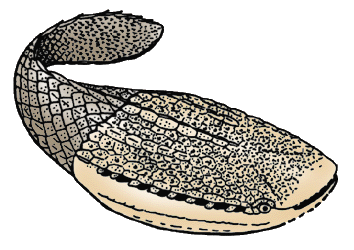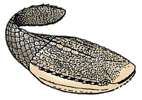Astraspida
Philippe Janvier
- Astraspis desiderata

- Astraspis splendens

Introduction
The Astraspida, or astraspids, are a small group of fossil, armored, fossil jawless vertebrates, which lived in the Middle Ordovician (about 450 million years ago) in North America. They are placed among the Pteraspidomorphi because of the large dorsal and ventral shield of their head armor. They are represented by a single genus, Astraspis, including possibly two species, A. desiderata and A. splendens, but their remains are fairly abundant in Ordovician sandstones of the USA (Colorado, Arizona, Oklahoma, Wyoming) and Canada (Quebec). The head armor of Astraspis is rather massive, with a series of ten gill openings lining the margin of the dorsal shield, and laterally placed eyes. The dorsal shield is ribbed by strong longitudinal crests, and the tail is covered with large, diamond-shaped scales.
Characteristics
Astraspids are characterized by:
- A dermal ornamentation of large, mushroom shaped tubercles of fine-tubuled dentine ('astraspidine'), covered with a thick, glassy cap of enameloid.
Astraspids and eriptychiids (see Eriptychiida) were the first Ordovician vertebrates ever discovered in the nineteeth century, and they have long been the only known Ordovician vertebrates, until the discovery of the arandaspids, in the 1970's. Therefore, their structure, though poorly known, has often been used in evolutionary scenarios to illustrate the primitive condition of the vertebrate dermal skeleton. Because of the acellular structure of their dermal skeleton, they were first regarded as heterostracans. Now, we know that they are widely different from heterostracans, in particular in retaining about ten separate external gill openings. However, they share with heterostracans the relatively dorsal position of these openings. Their dorsal and ventral shield is made up by numerous polygonal platelets of aspidine, ornamented with large dentine tubercles capped with a thick enameloid layer. Nothing is known of their internal anatomy, but they possessed a sensory-line system housed in grooves of the dermal plates.
Discussion of Phylogenetic Relationships
Astraspids are regarded as more closely related to heterostracans than to arandaspids, because of the dorsolateral position of their gill openings.
References
Denison, R. H. (1967). Ordovician vertebrates from Western United States. Fieldiana: Geology, 16, 269-288.
Elliott, D. K. (1987). A reassessment of Astraspis desiderata, the oldest North American vertebrate. Science, 237, 190-192.
Ørvig, T. (1958). Pycnaspis splendens new genus, new species, a new ostracoderm from the Upper Ordovician of North America. Proceedings of the United States National Museum, 108, 1-23.
Ørvig, T. (1989). Histologic studies of ostracoderms, placoderms and fossil elasmobranchs. 6. Hard tissues of Ordovician vertebrates. Zoologica Scripta, 18, 427-446.
Sansom, I. J. and Smith, P. (in press). Astraspis - The anatomy and histology of an Ordovician fish. Palaeontology.
Smith, M. M. (1991). Putative skeletal neural crest cells in Early Late Ordovician vertebrates from Colorado. Science, 251, 301-303.
Walcott, C. (1892). Notes on the discovery of a vertebrate fauna in the Silurian (Ordovician) strata. Bulletin of the Geological Society of America, 3, 153-172.
Title Illustrations

| Scientific Name | Astraspis desiderata |
|---|---|
| Location | Colorado |
| Comments | Astraspids are still poorly known but recent discoveries of partially complete specimens of Astraspis desiderata, from the Ordovician of Colorado, have considerably increased their knowledge. Their dorsal headshield is made up by large, polygonal bone units and the gill openings are situated more dorsally than in arandaspids. |
| Reference | After Janvier 1996, modified from Elliott, D. K. (1987). A reassessment of Astraspis desiderata, the oldest North American vertebrate. Science, 237:190-192. |
| Specimen Condition | Fossil -- Period: Ordovician |
| Image Use |
 This media file is licensed under the Creative Commons Attribution License - Version 3.0. This media file is licensed under the Creative Commons Attribution License - Version 3.0.
|
| Copyright |
© 1997

|
About This Page

Muséum National d'Histoire Naturelle Paris, France
Page copyright © 1997
 Page: Tree of Life
Astraspida.
Authored by
Philippe Janvier.
The TEXT of this page is licensed under the
Creative Commons Attribution License - Version 3.0. Note that images and other media
featured on this page are each governed by their own license, and they may or may not be available
for reuse. Click on an image or a media link to access the media data window, which provides the
relevant licensing information. For the general terms and conditions of ToL material reuse and
redistribution, please see the Tree of Life Copyright
Policies.
Page: Tree of Life
Astraspida.
Authored by
Philippe Janvier.
The TEXT of this page is licensed under the
Creative Commons Attribution License - Version 3.0. Note that images and other media
featured on this page are each governed by their own license, and they may or may not be available
for reuse. Click on an image or a media link to access the media data window, which provides the
relevant licensing information. For the general terms and conditions of ToL material reuse and
redistribution, please see the Tree of Life Copyright
Policies.
Citing this page:
Janvier, Philippe. 1997. Astraspida. Version 01 January 1997 (under construction). http://tolweb.org/Astraspida/16906/1997.01.01 in The Tree of Life Web Project, http://tolweb.org/








 Go to quick links
Go to quick search
Go to navigation for this section of the ToL site
Go to detailed links for the ToL site
Go to quick links
Go to quick search
Go to navigation for this section of the ToL site
Go to detailed links for the ToL site